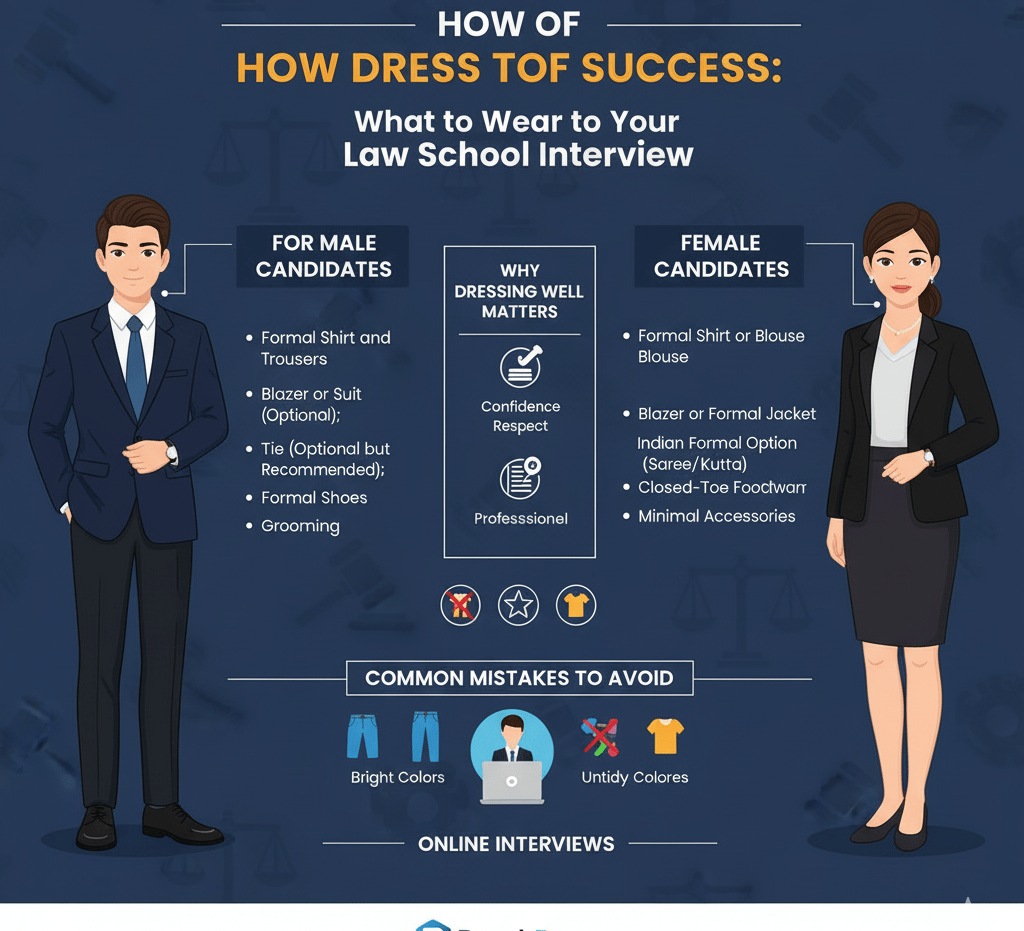👔 Dress to Impress: What to Wear for Your Law School Interview
Your first impression starts before you even speak! 💼 Learn how to dress smartly and professionally for your law school interview — from perfect formal outfits to grooming and body language tips. ResultPrep Coaching helps you look confident, composed, and ready to ace your CLAT or CUET Law interview like a true future lawyer. ⚖️
LAW ENTRANCE
10/9/20253 min read


Interview Prep: How to Dress for Success: What to Wear to Your Law School Interview
Introduction
A law school interview is not just about how much you know—it’s also about how you present yourself. First impressions play a huge role in shaping an interviewer’s perception of your confidence, professionalism, and suitability for the legal field. The way you dress reflects your respect for the opportunity and your understanding of what’s expected in the legal profession. Dressing for success doesn’t mean wearing something extravagant; it means choosing an outfit that’s neat, confident, and appropriate.
This guide will help you understand how to dress smartly and confidently for your law school interview, whether it’s for CLAT-based law schools, private universities, or foreign law programs.
Why Dressing Well Matters
Law is a profession that values discipline, structure, and decorum. When you appear for an interview, your attire communicates these qualities even before you speak.
A well-dressed candidate signals that they are:
Serious about the opportunity
Respectful toward the institution and interviewers
Confident and self-aware
Capable of fitting into a professional environment
In short, dressing appropriately shows that you understand what it means to be part of the legal fraternity.
For Male Candidates: The Ideal Law School Interview Look
Formal Shirt and Trousers: Choose a well-fitted light-colored shirt (white, light blue, or pale grey) with formal trousers in navy blue, charcoal, or black.
Blazer or Suit (Optional): If it’s a formal university interview or scholarship round, a simple blazer in navy or black adds polish. Avoid flashy patterns.
Tie (Optional but Recommended): A plain or minimally patterned tie can complete the formal look. Stick to subtle colors like navy, maroon, or grey.
Footwear: Wear clean, polished formal shoes (black or brown). Avoid sneakers or casual loafers.
Grooming: Maintain neat hair, trimmed nails, and avoid overpowering perfumes or colognes.
Pro Tip: Iron your clothes and check for wrinkles. Even the most expensive outfit can look sloppy if it’s not well-maintained.
For Female Candidates: Professional, Polished, and Poised
Formal Shirt or Blouse: Light shades like cream, white, pastel pink, or sky blue look elegant. Pair it with dark trousers or a pencil skirt.
Blazer or Formal Jacket: A well-fitted blazer in navy or black conveys authority and confidence.
Indian Formal Option: A neatly ironed cotton or silk saree or a formal kurta with trousers is also acceptable, provided it’s simple and professional.
Footwear: Opt for closed-toe flats or low heels. Avoid sandals or flip-flops.
Accessories: Keep jewelry minimal—small earrings or a simple watch are enough.
Grooming: Tie your hair neatly and use light makeup for a fresh, confident look.
Pro Tip: Comfort is key. Choose an outfit that allows you to move easily without looking casual.
Common Mistakes to Avoid
Wearing Casual Clothes: Jeans, T-shirts, and sneakers are too informal for a professional interview.
Bright or Flashy Colors: Stick to subtle, professional tones.
Over-accessorizing: Heavy jewelry, bold makeup, or flashy watches can distract interviewers.
Untidy Appearance: Wrinkled clothes, messy hair, or unpolished shoes give a careless impression.
Ignoring Fit: An outfit that’s too tight or too loose can look unprofessional and affect confidence.
Body Language Complements Your Outfit
Dressing well is only part of the impression. Combine it with positive body language:
Maintain good posture.
Offer a polite handshake.
Smile naturally.
Make eye contact during conversations.
Avoid fidgeting or crossing your arms.
These subtle gestures reinforce your confidence and professionalism, creating a balanced impression.
What to Wear for Online Interviews
In case your law school interview is conducted online, appearance still matters.
Dress fully in formals (not just the upper half).
Ensure good lighting and a neutral background.
Sit upright and maintain eye contact with the camera.
Keep accessories and distractions minimal.
Even online, your visual presentation speaks volumes about your seriousness toward the opportunity.
Final Tips for Dressing for Success
Try on your outfit a few days before the interview to ensure comfort and fit.
Get your clothes cleaned and pressed in advance.
Avoid experimenting with new styles or accessories on the day of the interview.
Confidence is your best accessory—wear it proudly.
Conclusion
Your law school interview is your gateway to a rewarding legal education and a professional career. Dressing appropriately is not about fashion—it’s about respect, discipline, and confidence. When you appear polished and poised, you automatically command respect and leave a lasting impression.
At ResultPrep Coaching, we prepare students not only for the CLAT and CUET Law interviews but also for the soft skills and presentation skills that make a lasting impact. Remember, your attire should reflect the lawyer you aspire to become—confident, composed, and professional.
📞 Call: 8970007497
🌐 Visit: www.resultprep.com
Prepare for the best results!
Achieve your goals with expert coaching and support from ResultPrep.
Contact us:
© 2025. All rights reserved.
Address:
GSS Complex, 2nd Floor,
16th Cross Rd, HMT Layout, Vidyaranyapura, Bengaluru, Karnataka- 560097
